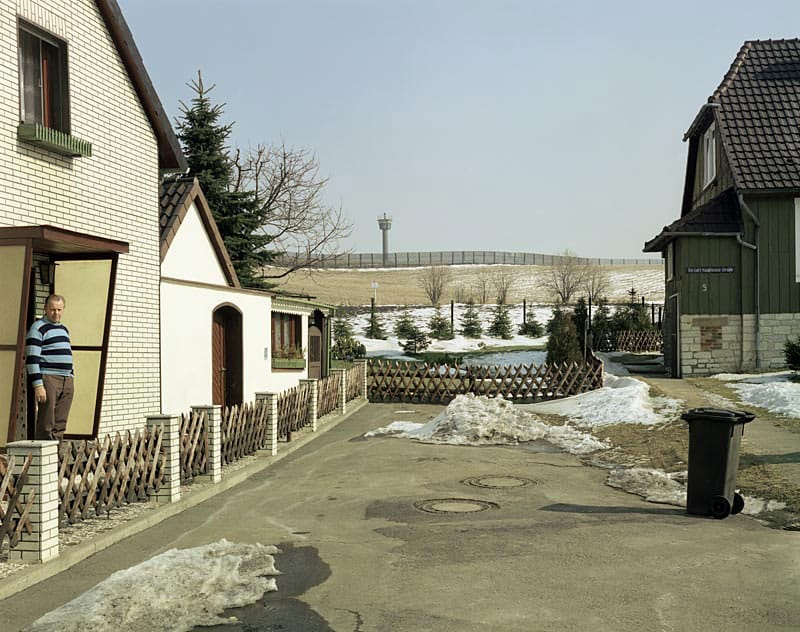The Lost Border
Working for 19 years on the fringe of the Iron Curtain, photographer Brian Rose captured the landscapes of central Europe with Bruegel’s sensitivity for how a setting tells a story. A conversation about his work, and a gallery of photos from his odyssey.

Interview by Rosecrans Baldwin
TMN: How did you come to be interested in the Iron Curtain? How did the book start?
BR: As a child I was an admirer of John F. Kennedy and I was aware of his trip to Berlin shortly after the Wall was erected. That was his famous “Ich bin ein Berliner” speech. I remember air raid shelters and duck and cover drills in school. Though I had a pretty serene childhood, the turmoil of the ‘60s and the Cold War had pretty big impact on me. My introduction to photography was Life magazine and the National Geographic, two periodicals my family subscribed to. I saved a copy of National Geographic with pictures of the Berlin Wall from the late ‘60s—I still have it—and almost 20 years later I made the subject my own. Continue reading ↓
All images used with permission, © copyright the artist, all rights reserved.












Interview continued
There were other more recent influences. Although I’ve looked at lots of photography over the years, I’ve probably been inspired more by movies than by still photographs. I liked the sweeping landscapes that were the backdrop of American road movies, but I was especially attracted to the more intellectual European filmmakers like Godard and Antonioni. I remember seeing Wim Wenders’s Kings of the Road in which two people travel along the East/West border. That’s the quintessential European road movie, freedom constantly being constrained by borders.
After reading Anthony Bailey’s account of his travels along the Iron Curtain in the New Yorker magazine, I decided to begin the project. I took a German language class, bought a plane ticket, rented a car, and traveled for five weeks. I had no idea it was the beginning of a 19-year odyssey.
I tried getting the project published several times. First in 1987 after I had fully documented the landscape of the border, then in 1990 after I had photographed the dismantling of the Berlin Wall. One rejection after another. I continued photographing the rebuilding of Berlin, and finally, in 2001, I put together a polished dummy and began approaching publishers again. This time, after showing the proposal to virtually every photo book publisher out there, Princeton Architectural Press took it on.
TMN: How did your perspective of the Iron Curtain change as you shot your pictures?
BR: I was quite shocked the first time I was confronted with the fortifications of the border. If I ever entertained thoughts about the moral equivalency of western democracy and Soviet communism, those notions were erased real fast when I saw how grim and forbidding East Germany was. Later, despite the enormous effort that went into maintaining the border apparatus, I came to realize how provisional it all was. The more I looked across, with my camera, and heard the voices of resistance from the other side, I became convinced that the Iron Curtain was not a permanent division.
TMN: In your travels, how did people you met react to your project?
BR: I had relatively little contact with people while traveling. It was often a very isolating experience traveling in the car day after day. It didn’t help that my German was poor, though I worked on it as best I could. Fifteen or 20 years ago Germans were not as proficient at English as they are now. In general, people were sympathetic to what I was doing. I was another border tourist, albeit with a 4x5 view camera. The western border guards didn’t give me any trouble, just a few warnings about stepping across the borderline into the no man’s land. In Berlin I could sense some resistance from the more sophisticated artists and intellectuals I came in contact with. The Wall and the Iron Curtain were too obvious, too present, too freighted with right-wing political capital. After the Wall came down in 1989 I discovered that I was the only art photographer who had documented the Iron Curtain in any kind of comprehensive way.
TMN: There’s such an aesthetic and pastoral loveliness to many of the photos—nothing to suggest a political and social battle ground. Were you ever swayed from remembering how the land was/is used?
BR: I never forgot for a moment that the landscape I was photographing was essentially a battleground, both in the present and in the past. In Berlin, the layering of history was and is conspicuous, but even on the rural landscape of Central Europe there were constant reminders of the events that have shaped history. Once, while searching for a road that would bring me to the German/Czech border I came across the site of a former Nazi concentration camp. After visiting the small documentation center there I looked around and realized that new houses had been built on the foundations of the former prison barracks, and an elementary school stood a short distance from the arched entry gate of the camp.
Much of society’s collective memory of the 20th century is defined by grainy black and white images: newsreels, videotape, or 35mm snapshots. This low-resolution, monochromatic, imagined reality differs greatly from the color view camera world I saw before me while doing the Lost Border project. For me, beauty and ugliness often coexist in the same place, under the same unblinking blue sky.
